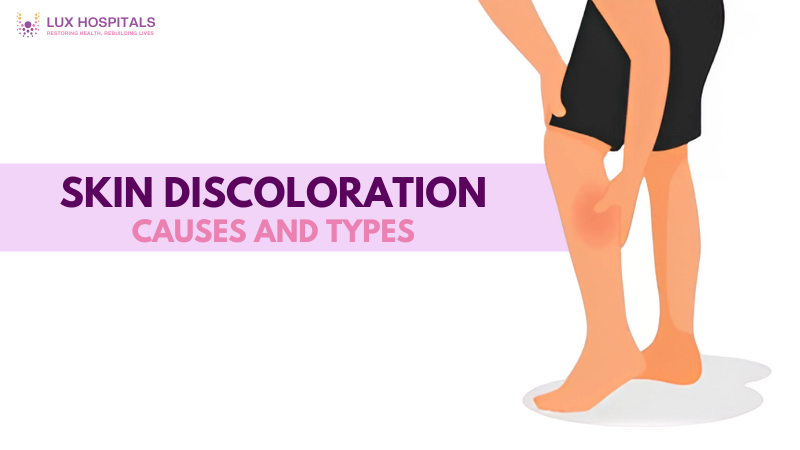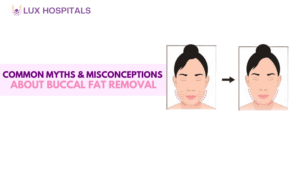Skin Discolouration: Causes, Types & When to See a Doctor?

Skin discolouration is common, in which certain skin regions develop lighter or darker skin than the surrounding tissue. While often harmless, it can sometimes indicate an underlying health issue. Understanding what causes skin discolouration, its various types, and when to see a doctor can assist you in making well-informed choices regarding your health and skin care. Understanding the causes, types, and when to seek medical help can empower you to take control of your skin health and overall well-being.
What is Skin Discoloration?
Skin discolouration refers to any change in your skin’s natural color, often appearing as lighter, darker, red, or even blue patches. These changes may occur due to pigment imbalances, injury, inflammation, or systemic illness. Though many forms of skin discolouration are benign, a healthcare professional should evaluate persistent or unusual changes.
Common Causes of Skin Discolouration
Several factors can lead to skin discolouration, ranging from harmless skin conditions to serious health concerns. Below are some of the most common causes:
1. Hyperpigmentation
- Hyperpigmentation results from excess melanin production, often triggered by sun exposure, hormonal changes, or skin injuries.
- Conditions like melasma and post-inflammatory hyperpigmentation fall into this category.
- It commonly causes dark patches, especially on the face, arms, and neck.
2. Hypopigmentation
- Lighter patches result from hypopigmentation, a condition in which the skin generates less melanin.
- Vitiligo and albinism are typical examples of skin appearing uneven or pale.
- These changes can be hereditary or autoimmune.
3. Infections
- Fungal and bacterial infections like tinea versicolor or cellulitis can lead to skin discolouration.
- These infections often come with other symptoms such as itching, peeling, or swelling.
- Treatment must be started right away to avoid more issues.
4. Inflammatory Skin Conditions
- Eczema, psoriasis, and acne can cause temporary or long-term skin discolouration.
- Post-inflammatory hyperpigmentation can persist even after the condition resolves.
- Managing the root condition can reduce the likelihood of lasting discolouration.
5. Medications and Chemicals
- Certain drugs, such as chemotherapy agents or antibiotics like minocycline, can lead to skin discolouration as a side effect.
- Topical treatments or chemical exposure may also alter pigment.
- Discolouration in these cases usually resolves after stopping the medication or exposure.
6. Underlying Medical Conditions
- Liver disease, kidney disorders, and diabetes can cause skin changes.
- Jaundice, for instance, gives the skin a yellowish hue due to liver dysfunction.
- Early medical evaluation is key when skin discolouration is linked to internal health issues.
Types of Skin Discolouration
Skin discolouration can appear in many forms. Understanding the type helps guide treatment and identify possible causes.
1. Melasma
- Common in women, especially during pregnancy or hormonal therapy.
- Presents as brown or gray-brown patches on the face.
- Sun exposure often worsens the condition.
2. Vitiligo
- An autoimmune condition causes white patches due to pigment loss.
- Affects both sides of the body symmetrically and may progress over time.
- Often requires medical treatment for cosmetic or emotional support.
3. Post-inflammatory Hyperpigmentation (PIH)
- Occurs after acne, burns, or other inflammatory conditions.
- Appear as dark spots where the skin was previously inflamed.
- It can fade over time with proper skincare and sun protection.
4. Birthmarks and Freckles
- These are often genetic and generally harmless.
- Freckles become more prominent with sun exposure.
- Birthmarks can be vascular (red) or pigmented (brown/black).
5. Acanthosis Nigricans
- Dark, velvety patches are typically found in skin folds like the neck or underarms.
- Often associated with insulin resistance and obesity.
- Requires medical attention to address the underlying cause.
When to See a Doctor?
While some types of skin discolouration are purely cosmetic, others may point to severe conditions. Consider visiting a healthcare provider if:
- The discolouration appears suddenly or spreads rapidly.
- It’s accompanied by itching, pain, or swelling.
- You experience other symptoms like fatigue, fever, or jaundice.
- The patches change in shape, size, or color over time.
- Treatments or over-the-counter remedies aren’t helping.
Early intervention ensures timely diagnosis and management of any underlying issues. A cosmetic surgeon can also offer guidance on cosmetic treatments for persistent skin discolouration.
Diagnosis of Skin Discolouration
Diagnosing skin discolouration typically starts with a physical examination and medical history. A cosmetic surgeon might use tools like a Wood’s lamp or perform a skin biopsy to understand the pigment changes. Blood tests may also be ordered to rule out systemic causes.
Treatment Options
The best treatment depends on the underlying cause of the skin discolouration:
- Topical creams like hydroquinone, retinoids, or corticosteroids
- Laser therapy or chemical peels for pigmentation reduction
- Oral medications in autoimmune or hormonal disorders
- Lifestyle changes like using sunscreen, avoiding irritants, and maintaining skin hydration
Consistency and medical guidance are crucial for managing skin discolouration effectively.
Conclusion
Skin discolouration is more than just a cosmetic issue it can indicate your overall health. While many cases are harmless and treatable, others require medical attention to diagnose underlying problems. By understanding the causes, types, and treatment options for skin discolouration, you can take better care of your skin and ensure peace of mind. Don’t ignore persistent or sudden changes early action always pays off. By paying attention to changes in your skin and being proactive about your health, you can manage skin discolouration effectively and maintain a more even, radiant complexion. Don’t hesitate to consult a cosmetic surgeon for expert guidance and care.
Frequently Asked Questions
Inflammation, allergic reactions, bruising, or infections can cause sudden skin discoloration. In some cases, it may signal a serious underlying condition like liver disease or vasculitis. For unexplained changes, immediate medical evaluation is recommended.
To prevent skin discolouration, use sunscreen daily, avoid harsh chemicals, and treat underlying skin conditions promptly. A balanced diet and proper hydration also support skin health. Early care reduces the risk of lasting discolouration
Some skin discolouration may be linked to skin cancer, especially if the spot changes shape, color, or size. Melanoma can present as a dark or unevenly colored patch. It’s essential to consult a cosmetic surgeon for proper evaluation.
To prevent skin discolouration, use sunscreen daily, avoid harsh chemicals, and treat underlying skin conditions promptly. A balanced diet and proper hydration also support skin health. Early care reduces the risk of lasting discolouration
A cosmetic surgeon is a specialist who consults for skin discoloration. They can diagnose the cause, recommend treatment, or refer you for further testing.




















